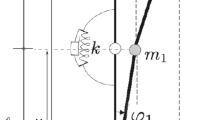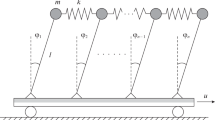Abstract
A discrete model of an elastic pendulum with a follower force is studied. This model is an inverted mathematical two-link pendulum with viscoelastic hinges. It is shown that divergent bifurcations are possible for some absolute values of the follower force and the stiffness of the restraint of the pendulum's upper end. As a result, the vertical position of the equilibrium becomes unstable and two new nonvertical stable equilibrium states (fork bifurcation) occur.
Similar content being viewed by others
REFERENCES
S. A. Agafonov, “On stability and self-oscillations of a double pendulum with elastic elements under a follower force,” Izv. RAN, Mekh. Tverd. Tela, No. 5, 185–190 (1992).
S. A. Agafonov “Stabilization of equilibrium of the Ziegler pendulum through parametric excitation,” Izv. RAN, Mekh.Tverd. Tela, No. 6, 36–40 (1997).
V. I. Arnol'd, V. S. Afraimovich, Yu. S. Il'yashenko, and L. P. Shil'nikov, “Bifurcation theory,” in: Advances in Science and Engineering, Current Problems of Mathematics. Dynamic Systems [in Russian], Vol. 5, VINITI, Moscow (1986), pp. 5–218.
V. G. Verbitskii and L. G. Lobas, “Real bifurcations of double-link rolling systems,” Prikl. Mat. Mekh., 60, No. 3, 418–425 (1996).
V. G. Verbitskii and L. G. Lobas, “Real bifurcations of dynamic systems with simple symmetry upon variation in the control parameters,” Probl. Upravl. Inform., No. 6, 47–62 (1995).
N. I. Zhinzher, “Influence of dissipative forces with incomplete dissipation on the stability of elastic systems,” Izv. RAN, Mekh. Tverd. Tela, No. 1, 149–155 (1994).
L. G. Lobas, “Nonlinear stability and pitchfork bifurcations in dynamic systems with simple symmetry,” Prikl. Mat.Mekh., 60, No. 2, 327–332 (1996).
Ya. G. Panovko and S. V. Sorokin, “On quasistability of viscoelastic systems with follower forces,” Izv. AN SSSR, Mekh.Tverd. Tela, No. 5, 135–139 (1987).
A. P. Seiranyan, “On the stabilization of nonconservative systems by dissipative forces and on the uncertainty of the critical load,” Dokl. RAN, 348, No. 3, 323–326 (1996).
I. G. Boruk and L. G. Lobas, “On the motion of a reversible double simple pendulum with tracking force,” Int. Appl.Mech., 35, No. 7, 745–750 (1999).
P. Hagedom, “On the destabilizing effect of non-linear damping in non-conservative systems with follower forces,” Int.J. Non-Linear Mech., 5, No. 2, 341–358 (1970).
G. Hermann and I.-C. Jong, “On the destabilizing effect of damping in nonconservative elastic systems,” Trans. ASME, Ser. E, J. Appl. Mech., E32, No. 3, 592–597 (1965).
E. Lindtner, A. Steindl, and H. Troger, “Stabilitätsverlust der gestreckten Lage eines raumlichen Doppelpendels mit elastischer Endlagerung unter einer Volgelast,” Z. angew. Math. Mech., 67, No. 4, 105–107 (1987).
L. G. Lobas, “Nonlinear stability and triple-equilibrium bifurcations in finite-dimensional dynamical systems with symmetry,” Eng. Simul., 14, No. 5, 713–725 (1997).
L. G. Lobas, “Bifurcations of steady states and periodic motions of finite-dimensional dynamical systems with simple symmetry,” Int. Appl. Mech., 34, No 1, 1–24 (1998).
L. G. Lobas, “The dynamics of finite-dimensional systems under nonconservative position forces,” Int. Appl. Mech., 37, No. 1, 38–65 (2001).
A. Pflüger, Stabilitätsprobleme der Elastostatik, Springer, Berlin–Göttingen–Heidelberg (1950).
R. H. Plaut, “A new destabilization phenomenon in nonconservative systems,” Z. Angew. Math. Mech., 51, No. 4, 319–321 (1971).
R. Scheidl, H. Troger, and K. Zeman, “Coupled flutter and divergence bifurcation of a double pendulum,” Int. J.Non-Linear Mech., 19, No. 2, 163–176 (1984).
A. Stribersky and H. Troger, “Globales Verzweigungsverhalten am Beispiel eines langselastischen Doppelpendels unter Volgelast,” Z. angew. Math. Mech., 68, No. 4, 126–128 (1988).
H. Troger and A. Steindl, Nonlinear Stability and Bifurcation Theory, Springer-Verlag, Vienna–New York (1991).
H. Troger and K. Zeman, “DeZur korrekten Modellbildung in der Dynamik diskreter Systeme,” Ingenieur-Archiv., 51, No. 1/2, 31–43 (1981).
H. Ziegler, “DeDie Stabilitätskriterien der Elastomechanik,” Ingenieur-Archiv., 20, No. 1, 49–56 (1952).
H. Ziegler, “Linear elastic stability,” Z. angew. Math. Phys., 4, No. 2, 89–121; No. 3, 167–185 (1953).
Author information
Authors and Affiliations
Rights and permissions
About this article
Cite this article
Lobas, L.G., Patricio, L.D. & Boruk, I.G. Equilibrium of an Inverted Mathematical Double-Link Pendulum with a Follower Force. International Applied Mechanics 38, 372–376 (2002). https://doi.org/10.1023/A:1016098615226
Issue Date:
DOI: https://doi.org/10.1023/A:1016098615226




